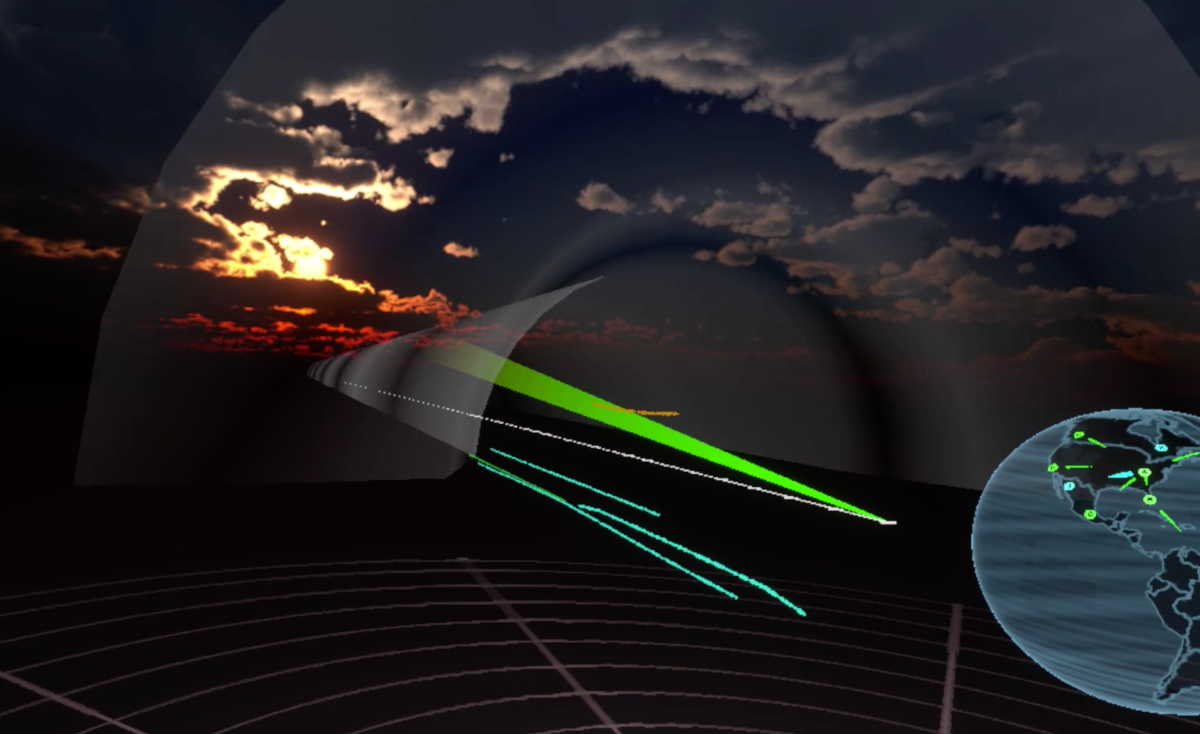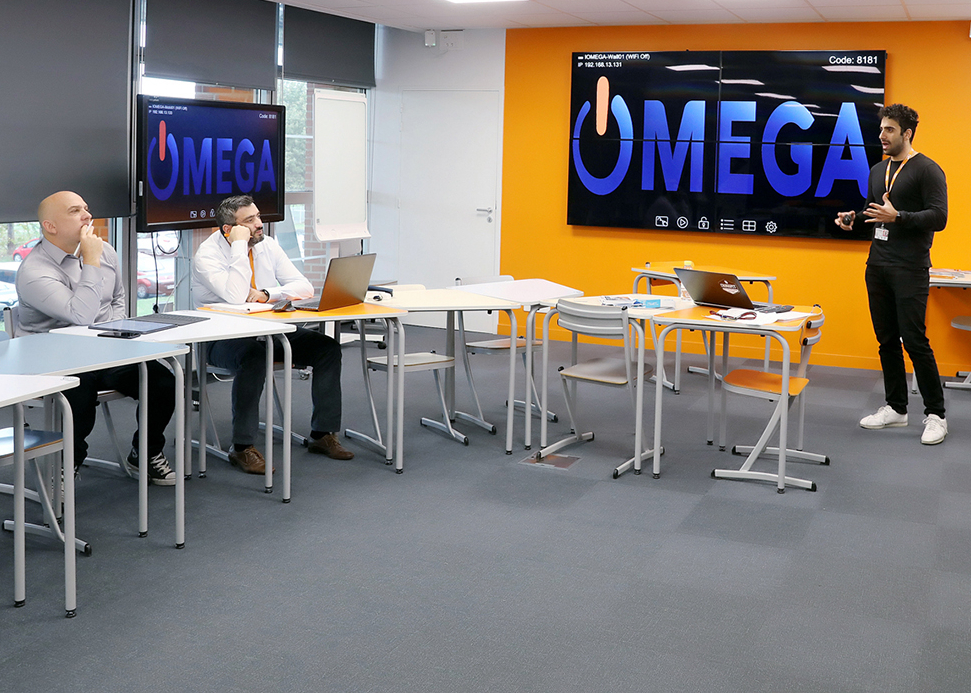Meet your supply chain using virtual reality
Immersive technologies for industrial engineering and risk management? This is the focus of research to be carried out at the SIReN laboratory launched on 15 November, bringing together researchers from IMT Mines Albi (France) and Georgia Tech (USA). On the French side, Frédérick Benaben, an expert in collaborative networks, is already using virtual reality to develop a supply chain decision support and management tool for companies.
In front of you, a beam of green light traces a path leading you straight to the finishing line. You’re continuing along this path when, suddenly, a floating red sphere comes flying right toward you! It makes you veer sharply from your path, taking you away from where you were headed. You now face a crucial question: how can you achieve your goal from this new point? This is not a revolutionary video game set to be released at the end of the year. It’s a decision support tool developed by researchers at IMT Mines Albi and Georgia Tech to facilitate the visualization of data produced by artificial intelligence.
Building on their collaboration begun in 2015, the two academic partners have continued their joint research since 15 November through SIReN[1], a new international associated laboratory jointly based in Albi and Atlanta. “At the laboratory, we’re carrying out research on how immersive technology can help us develop and manage response networks,” explains Frédérick Benaben, an IMT Mines Albi researcher who specializes in the field of collaborative networks and information systems. Such networks include supply chains and crisis management. The researchers’ expertise is based on an original vision of artificial intelligence, at the crossroads between industrial engineering and computer and data sciences, and on a partnership that is already as concrete as the work it seeks to carry out.
Making the abstract concrete with virtual reality
A supply chain is a dynamic system that must be as agile as possible. It evolves over time in response to opportunities (opening of a new market, tax reductions etc.) or risks (weather events, closing of a border etc). Yet, understanding how these various events could impact the supply chain proves to be very complex. That’s where virtual reality comes in!
Read more on I’MTech: What is supply chain management?
Unlike “traditional” uses of virtual reality where the aim is to represent a copy of reality, as with digital twins for example, the researchers use virtual reality to get away from reality. “We can then project ourselves into a world where our physical reference points (such as up and down, distance, etc.) are conserved, but where we have the possibility of visualizing abstract concepts. Using spheres, we represent opportunities or risks, for example. Color effects can indicate how dangerous they are,” says the researcher.
In the virtual universe, the spatio-temporal reference points are defined by the set of performance indicators for a supply chain. Let’s consider a simplified case where there are only three indicators: cost, product quality and delivery time. The researchers therefore define a three-dimensional frame of reference in which the supply chain is situated. Like a mechanical force, each risk or opportunity that has an impact on the network will push or pull it in a certain direction. For example, flooding along a delivery route will push the supply chain down on the delivery time axis.

Through virtual reality, a user can observe a supply chain, move and observe risks and opportunities related to the supply chain.
In reality, logistics networks have dozens of performance indicators and over a hundred risks and opportunities — and therefore mechanical forces — to represent at each instant, making them complex to visualize. This is made possible through extensive work to identify and process data. To continue with the flooding example, data is identified such as the number of blocked routes, how delayed the trucks are, the percentage of damaged warehouses, implications for the products etc. The researchers turn this information into a macroscopic force exerted on the performance indicators.
Read more on I’MTech: C2Net: supply chain logistics on cloud nine
Virtual reality therefore helps respond to a need for agility in supply chains in an interactive way. Once the users are immersed in their supply chain universe, they can follow its movement and also interact with the supply chain. The spheres representing risks and opportunities are closer or further from the user based on how likely they are to occur. Their color indicates how dangerous they are, making it possible to identify areas of action more effectively. “The user steers the course of their system towards a precise objective. Virtual reality allows them to identify the forces they must use to achieve their goal, much like a sailor uses winds and currents. If a risk materializes, they deviate from the path but may be able to use a force to correct the effect,” explains Frédérick Benaben.
This decision support tool could also help anticipate the effects of an event on the path and avoid it, if possible. These are precisely the questions being explored through the SCAN research program (Agile, Digital Collaborative Systems) launched in September 2019 with Scalian, a company that specializes in digital transformation, conducted through the SIReN laboratory.
Virtuality and risk management
The supply chain is not the only area of research to benefit from virtual reality through the SIReN laboratory. In March 2019, researchers from IMT Mines Albi created the EGCERSIS[2] research program with support from the Occitanie region and in partnership with the companies Immersive Factory and Report One. The aim is to use immersive technologies to develop crisis management systems for sensitive industrial environments. In particular, they are building on an emerging need expressed by Immersive Factory, a company specialized in developing digital twins to provide safety training for staff at industrial sites. The company is seeking to expand its offerings by providing training for crisis situations. Employees may have already learned how to make sure a valve is closed after using it, but what should they do if it catches on fire? The four-year partnership will be based on demonstrating the strength of digital simulation to respond to this sort of issue.
To do so, the researchers will rely on the IOMEGA platform equipped with multi-screen interfaces displayed in the form of a cockpit, allowing interaction between software, artificial intelligence visualization etc. They will also take advantage of state-of-the-art equipment for immersion and virtual reality, giving users 360° freedom of movement, via the new IOMEGA VR platform launched on 15 November. On the other side of the Atlantic, a twin platform is being developed at Georgia Tech.
More generally, the two partner institutions will draw on their complementary expertise for the projects carried out through SIReN. They seek to increase the agility of collaborative networks but come at the problem from two different angles. The French team is developing technologies intended for the supply chain, while the American team has given rise to the concept of the physical internet, which aims to transport physical goods as efficiently as data is transmitted over the internet. Like the internet, logistics must become fluid, and immersive technologies have a key role to play in making this possible.
[1] Sentient Immersive Response Network
[2] Crisis Management Training in an Environment Representative of Sensitive Industrial Sites





Leave a Reply
Want to join the discussion?Feel free to contribute!